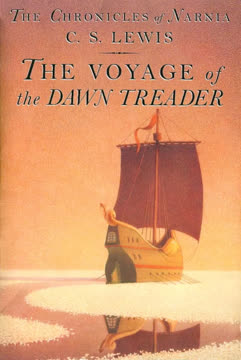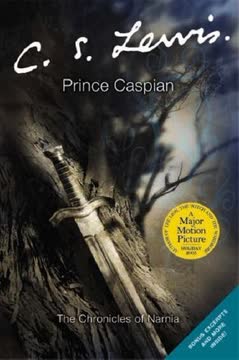Plot Summary
The Picture That Transports
Edmund and Lucy Pevensie, spending a dreary summer with their insufferable cousin Eustace, find solace in memories of Narnia. One afternoon, a painting of a ship on the sea in Lucy's room comes alive, and the three children are swept through the frame into the ocean. Rescued by the crew of the Dawn Treader, they are reunited with King Caspian and the valiant mouse Reepicheep. Eustace, unprepared for adventure, is terrified and seasick, while Edmund and Lucy are thrilled to return to Narnia's magic. The painting's transformation marks the beginning of a journey that will test each of them, especially Eustace, in ways they cannot yet imagine.
Aboard the Dawn Treader
Onboard, Caspian explains his mission: to seek the seven lost lords exiled by his usurping uncle, Miraz, and to sail as far east as possible, perhaps to Aslan's own country. The ship's crew is a mix of Narnians and loyal friends, with Reepicheep's dream of reaching the world's end inspiring all. Eustace, out of his element, clashes with Reepicheep and the others, his selfishness and ignorance making him an outsider. The ship's camaraderie and sense of purpose contrast with Eustace's isolation, setting the stage for his transformation. The voyage promises adventure, danger, and the hope of redemption for all.
Lone Islands: Slavery and Freedom
The Dawn Treader reaches the Lone Islands, where Caspian and his friends are captured by slave traders. Caspian is bought by Lord Bern, one of the lost lords, who helps him reclaim his identity. With cunning and courage, Caspian overthrows the corrupt governor, abolishes slavery, and appoints Bern as Duke. The episode tests the group's unity and Caspian's leadership, while Eustace's self-centeredness is highlighted by his inability to grasp the gravity of their predicament. The liberation of the islands is a triumph of justice and mercy, reinforcing the quest's moral purpose.
Eustace's Dragonish Transformation
After a fierce storm, the ship is damaged and the crew lands on a remote island for repairs. Eustace, avoiding work, wanders off and discovers a dragon's lair filled with treasure. Greedily taking a bracelet, he falls asleep and awakens transformed into a dragon—his outward form now matching his inner selfishness. Isolated and miserable, Eustace realizes the pain he has caused others. His attempts to communicate his identity to the crew are met with fear, but gradually, his actions—helping with repairs and providing food—begin to redeem him in their eyes.
Redemption and Rebirth
Eustace's transformation is both physical and spiritual. One night, Aslan appears to him, guiding him to a well and instructing him to shed his dragon skin. Eustace tries, but only Aslan's claws can truly remove the layers of selfishness and pride. The process is painful but cleansing, and Eustace emerges as a boy again—humbled, grateful, and changed. His return to the group is met with relief and joy. Though not perfect, Eustace's journey from dragon to boy marks the beginning of his true growth, illustrating the power of grace and the possibility of redemption.
Perils of the Sea
The voyage continues, bringing new challenges. The crew faces a sea serpent that nearly destroys the ship, and they narrowly escape an island whose waters turn everything to gold—tempting them with greed and nearly causing a rift between Caspian and Edmund. The group's unity is tested by these external and internal threats, but Aslan's subtle interventions guide them back to their purpose. Each trial reveals the characters' strengths and weaknesses, deepening their bonds and preparing them for the greater mysteries ahead.
The Island of Voices
The Dawn Treader lands on an island where the crew is beset by invisible enemies—the Dufflepuds, comical and foolish creatures rendered invisible by a magician's spell. The Dufflepuds, desperate to be seen again, coerce Lucy into entering the magician's house to find the spell that will restore their visibility. The episode is filled with humor and anxiety, as Lucy's courage is tested and the group must rely on her resourcefulness. The invisible threat becomes an opportunity for growth and understanding, both for Lucy and the Dufflepuds.
Lucy and the Magician's Book
Alone in the magician's house, Lucy finds the spellbook and is tempted by spells that promise beauty and knowledge. She resists the urge to use magic for selfish ends, guided by Aslan's presence and her own conscience. Lucy's journey through the book is a microcosm of the larger quest: the struggle between desire and virtue, the allure of power, and the importance of humility. Ultimately, she finds the spell to make things visible, restoring the Dufflepuds and the magician, Coriakin, to sight. Lucy's integrity and bravery are affirmed, and she is rewarded with Aslan's approval.
The Dufflepuds' Delight
With their visibility restored, the Dufflepuds—now called Monopods—celebrate, embracing their unique appearance and newfound happiness. The magician, Coriakin, reveals himself as a benevolent guide, and the crew is treated to magical hospitality. The episode is a celebration of difference and acceptance, as the Dufflepuds learn to value themselves and the Narnians appreciate the island's wonders. The crew departs with gifts and new maps, their spirits lifted and their sense of wonder renewed.
The Dark Island of Fear
The Dawn Treader sails into a darkness that is not mere night but the embodiment of fear and despair—a place where dreams, especially nightmares, come true. The crew is paralyzed by terror until Lucy prays for help, and Aslan, in the form of an albatross, leads them to safety. They rescue Lord Rhoop, one of the lost lords, driven mad by his time on the island. The episode is a powerful allegory for confronting inner darkness, the necessity of courage, and the sustaining power of faith and hope.
The Three Sleeping Lords
The ship reaches an island where three of the lost lords lie in an enchanted sleep at a banquet table. The cause: a quarrel over whether to continue east, resolved only by a magical sleep. The travelers learn that to break the spell, they must journey to the world's end and leave one of their company behind. The episode is a meditation on limits, sacrifice, and the cost of seeking ultimate truths. The presence of Ramandu, a retired star, and his daughter adds a sense of cosmic wonder and destiny to the quest.
Ramandu's Island and the Star
On Ramandu's island, the crew is refreshed and given counsel. Ramandu explains the conditions for breaking the enchantment and the nature of the world's end. The crew must choose who will continue and who will return. Caspian, torn between duty and desire, is reminded by his friends and Aslan's unseen guidance of his responsibilities as king. The episode is a turning point, as the quest narrows to its final, most mystical stage, and the travelers prepare for the unknown.
The Silver Sea and Sweet Waters
Sailing east, the Dawn Treader enters a sea of lilies and sweet water, where the sun grows larger and the world more luminous. The crew needs less food and sleep, and a sense of awe pervades the ship. They glimpse sea people and marvel at the beauty and strangeness of the world's edge. The journey becomes increasingly spiritual, as the boundaries between the physical and the transcendent blur. The travelers are transformed by the experience, their senses heightened and their hearts filled with longing for Aslan's country.
The End of the World
The ship can go no further, and Caspian is persuaded to return to Narnia, leaving Edmund, Lucy, Eustace, and Reepicheep to continue in a small boat. The sea becomes shallower, filled with lilies, and the light grows unbearable. At last, they reach a wall of water and glimpse mountains beyond the sun—Aslan's country. Reepicheep, fulfilling his lifelong dream, sails alone into the unknown, joyful and unafraid. The others are met by Aslan, who appears first as a lamb and then as himself, and are told they must return to their own world.
Aslan's Country Revealed
Aslan explains that Edmund and Lucy will not return to Narnia, as they are now too old and must come to know him by another name in their own world. Eustace's fate is left open, but he has been changed by the journey. The children are comforted by Aslan's promise that he is present in all worlds, and that their time in Narnia was meant to prepare them for deeper truths. The vision of Aslan's country lingers as a symbol of hope, fulfillment, and the ultimate destination of all quests.
Farewells and Homecoming
The children are sent back through the door in the sky, returning to the mundane world of Aunt Alberta's house. Eustace is notably changed—kinder, humbler, and more courageous—though only those who know him well understand the depth of his transformation. Caspian returns to Narnia, marries Ramandu's daughter, and rules wisely. The voyage has left all its participants forever altered, their hearts marked by the beauty, trials, and revelations of their journey. The story ends with the assurance that Aslan's country awaits, and that the lessons of Narnia endure beyond its borders.
Characters
Edmund Pevensie
Edmund, the second-youngest Pevensie, is marked by his past betrayal in Narnia and subsequent redemption. He is rational, brave, and protective of Lucy, often acting as a mediator and voice of reason. Edmund's journey is one of maturity—he resists temptation, supports Caspian's leadership, and shows empathy for Eustace's struggles. His experience in Narnia has made him humble and self-aware, and he serves as a moral anchor for the group. Edmund's growth is evident in his willingness to challenge Caspian when necessary and his acceptance of Aslan's will, even when it means leaving Narnia forever.
Lucy Pevensie
The youngest Pevensie, Lucy is characterized by her unwavering faith in Aslan and her open-heartedness. She is sensitive to magic and beauty, often seeing Aslan when others cannot. Lucy's journey in this story centers on temptation and self-worth, particularly during her encounter with the magician's book. Her ability to resist using magic for selfish ends and her compassion for others make her a moral exemplar. Lucy's relationship with Aslan is deeply personal, and her sorrow at leaving Narnia is tempered by the promise of his presence in her own world.
Eustace Clarence Scrubb
Eustace begins as a thoroughly unpleasant boy—selfish, cynical, and dismissive of magic. His transformation into a dragon is a physical manifestation of his inner flaws, and his subsequent redemption is the emotional heart of the story. Through suffering, humility, and Aslan's intervention, Eustace becomes kinder, braver, and more self-aware. His journey is one of self-discovery and grace, illustrating the possibility of change even for the most unlikely characters. Eustace's development is ongoing, but his experience in Narnia marks the beginning of a new, better self.
Caspian X
Caspian is noble, courageous, and driven by a sense of duty—to his people, to the lost lords, and to Aslan. His leadership is tested by the challenges of the voyage, the temptations of power, and the need to balance personal desire with responsibility. Caspian's willingness to listen to his friends and accept correction demonstrates his humility. His romance with Ramandu's daughter and his eventual return to Narnia signal his growth from adventurer to wise ruler. Caspian embodies the ideal of servant leadership, guided by faith and a longing for the divine.
Reepicheep
Reepicheep is the embodiment of chivalry, courage, and unyielding hope. His dream of reaching Aslan's country drives the voyage and inspires the crew. Though small in stature, Reepicheep's heart is immense, and his willingness to face any danger for honor and adventure is both comic and profound. He serves as a mentor to Eustace, offering comfort and wisdom. Reepicheep's final journey into the unknown is a poignant symbol of faith, longing, and the ultimate quest for meaning.
Aslan
Aslan, the great lion, is the spiritual center of the story. He appears at pivotal moments—guiding, comforting, and challenging the characters. Aslan's interventions are subtle yet transformative, offering grace to Eustace, wisdom to Lucy, and correction to Caspian. He represents the presence of the divine in all worlds, and his country is the ultimate destination for those who seek truth and goodness. Aslan's message is one of hope, redemption, and the assurance that every journey has a purpose beyond its apparent end.
Lord Bern
One of the seven lost lords, Bern becomes Duke of the Lone Islands after helping Caspian overthrow the corrupt governor. He is wise, practical, and devoted to justice. Bern's story is one of exile and restoration, mirroring the larger themes of the book. His loyalty to Caspian and his people is unwavering, and his leadership helps bring freedom and prosperity to the islands.
Ramandu
Ramandu is a celestial being who guides the travelers at the world's edge. His presence adds a sense of cosmic wonder and destiny to the quest. Ramandu's wisdom helps the crew understand the conditions for breaking the enchantment and the nature of the world's end. He represents the mystery and majesty of the universe, reminding the characters of their place in a larger, divinely ordered cosmos.
Ramandu's Daughter
The daughter of Ramandu is a figure of beauty, wisdom, and serenity. She explains the enchantment of the sleeping lords and becomes Caspian's beloved. Her presence is both comforting and challenging, inviting the travelers to trust in the unknown and to seek the highest good. She embodies the promise of renewal and the possibility of love that transcends worlds.
Coriakin
Coriakin, the magician of the Dufflepuds' island, is both a figure of power and a humble servant. Tasked with guiding the foolish Dufflepuds, he uses magic to teach them wisdom and self-acceptance. Coriakin's interactions with Lucy and the crew are marked by kindness, patience, and a gentle sense of humor. He represents the transformative power of guidance and the importance of accepting one's role in the world.
Plot Devices
Magical Realism and Allegory
The narrative structure of "The Voyage of the Dawn Treader" is episodic, with each island representing a different moral or spiritual challenge. Magic is woven seamlessly into the fabric of the world, serving as both a source of wonder and a test of character. Foreshadowing is used throughout—Reepicheep's prophecy, the recurring presence of Aslan, and the hints of the world's end all build anticipation and thematic unity. The journey eastward is both a literal voyage and a metaphor for spiritual growth, with each trial revealing deeper truths about the characters and the nature of reality. The use of transformation (Eustace's dragoning), enchantment (the sleeping lords), and revelation (Aslan's appearances) underscores the book's central message: that true adventure is a journey of the soul, guided by grace, courage, and the pursuit of the divine.
Analysis
"The Voyage of the Dawn Treader" is a profound meditation on transformation, redemption, and the longing for transcendence. Through its episodic structure, the book explores the temptations and trials that shape character—greed, pride, fear, and the desire for power—while offering hope that even the most flawed can be redeemed. Eustace's journey from selfishness to humility is a microcosm of the human condition, illustrating the necessity of grace and the pain of true change. The voyage itself is an allegory for the spiritual quest, with Aslan's country representing the ultimate fulfillment of all longing. Lewis's narrative invites readers to embrace wonder, to confront their own darkness, and to trust in the presence of the divine, even when unseen. The story's enduring appeal lies in its affirmation that every journey, no matter how perilous, is guided by love and leads, ultimately, to home.
Last updated:
Review Summary
The Voyage of the Dawn Treader is a beloved installment in the Narnia series, praised for its imaginative adventures and character development. Readers appreciate the nautical setting, magical encounters, and moral lessons. Many consider it their favorite book in the series, lauding Lewis's vivid descriptions and storytelling. Some criticize pacing issues and religious overtones, but most find it a captivating tale of growth and discovery. The character of Eustace and his transformation are particularly well-received. Overall, it's regarded as a classic of children's fantasy literature.
The Chronicles of Narnia (Chronological Order) Series
Similar Books








Download PDF
Download EPUB
.epub digital book format is ideal for reading ebooks on phones, tablets, and e-readers.













